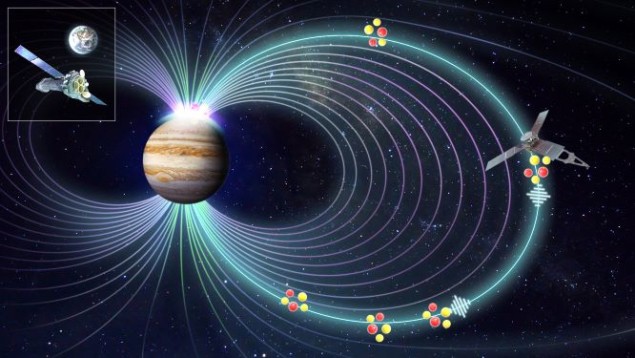
The mechanisms behind the energetic X-ray flares in Jupiter’s version of the Northern Lights are remarkably similar to those that produce Earth’s aurora, an international team of astronomers has discovered. Using simultaneous observations by two different satellites, researchers co-led by William Dunn at University College London and Zhonghua Yao at the Chinese Academy of Sciences determined that both processes are driven by vibrations in planetary magnetic fields – a phenomenon that could be universal even among planets that have very different magnetospheres.
As volcanic gases erupt from Jupiter’s innermost moon, Io, the heavy sulphur and oxygen ions they contain form a donut-shaped ring of plasma around the planet. From there, these particles gradually move along Jupiter’s magnetic field lines to fill its magnetosphere. Eventually, some of the ions strike Jupiter’s polar atmosphere. The large amount of energy they deposit produces spectacular, highly energetic X-ray bursts in Jupiter’s aurora every 27 minutes.
Since X-rays are typically only generated in far more extreme environments such as black holes or neutron stars, these bursts (and their clockwork-like regularity) have intrigued astronomers ever since they were discovered 40 years ago. Despite widespread interest, however, the exact mechanisms that drive such regular X-ray pulses have remained a mystery.
Simultaneous observations
In their study, Dunn, Yao and colleagues examined the pulses using simultaneous observations from two different spacecraft: NASA’s Juno satellite, which orbits Jupiter and takes in situ measurements of its magnetosphere; and ESA’s XMM-Newton observatory, which monitors the planet remotely from its orbit around the Sun. By analysing 26 hours of observations from each instrument, the astronomers determined that Jupiter’s X-rays are driven by periodic vibrations in the planet’s strong, rapidly-rotating magnetic field.
Although the source of these vibrations is still unknown, the team’s observations revealed that they transfer energy to the heavy ions emitted by Io – essentially allowing these charged particles to “surf” along Jupiter’s magnetic field lines. This generates regular waves of energetic plasma, which in turn produce energetic X-ray flares as they impact the planet’s atmosphere.

Juno space probe identifies changes in Jupiter’s magnetic field
Remarkably, Dunn and Yao’s team discovered that although this specific process appears to be unique to Jupiter, it is strikingly similar to mechanisms that occur in Earth’s magnetic field, where far more subtle field-line vibrations generate less energetic plasma waves. This means that despite the several-orders-of-magnitude differences in the time, space, and energy scales of the two planetary systems’ flare mechanisms, they ultimately have a common source.
By extension, the astronomers suggest that this mechanism could be universal across many different planetary environments. They now hope to capture similar mechanisms playing out in the magnetospheres of Saturn, Uranus, and Neptune, and perhaps even giant exoplanets.
The research is described in Science Advances.



